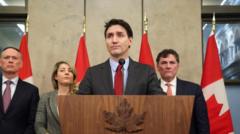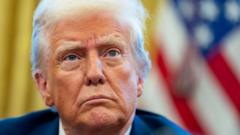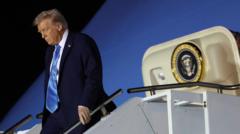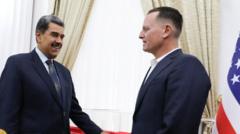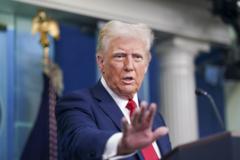In a world already facing unprecedented health challenges, the possibility of a second Trump administration is raising alarms among global health advocates. Trump’s historical stance against international institutions and his inclination to slash foreign aid threaten to exacerbate financial hardships for organizations striving to manage and combat infectious diseases.
Trump's Return Could Intensify Financial Challenges for Global Health Initiatives

Trump's Return Could Intensify Financial Challenges for Global Health Initiatives
As Donald Trump's potential comeback looms, global health organizations brace for funding cuts that could hinder vital health programs.
The current landscape for global health is fraught with difficulties as rates of diseases such as dengue fever are soaring throughout Latin America. Health organizations are urgently seeking substantial financial support to combat not only the escalating cases of the mutated mpox virus and potential spread of avian influenza H5N1 but also the rise in deaths from cholera and measles. The challenge is further heightened by the emergence of drug-resistant parasites impacting malaria treatment and the invasive spread of malaria-carrying mosquitoes threatening urban centers in Africa.
These global health entities have been instrumental in reducing child mortality rates by over 50% in the last two decades. Innovative interventions like distributing bed nets have significantly curbed malaria infections, and with improved treatments, H.I.V. has transitioned from a leading cause of death to a manageable chronic illness in numerous regions. However, as they strive to fulfill their financial requests, they are met with a grim reality: funding limitations are set to impede their operations significantly.
The rising demands compete with increasing international pressures, including climate change and conflicts, which further strain already diminished aid budgets from traditional donor countries such as the UK, Germany, and Japan. Organizations are particularly apprehensive about the pattern of decreased contributions from the U.S. should Trump assume office once again, which may dramatically reshape support for vital health initiatives worldwide.
In this climate of uncertainty, there is heated discussion regarding the future structure of global health systems and their sustainability. The impending need for a reassessment indicates that only through innovative funding mechanisms and engagements can these organizations hope to navigate the complexities of delivering essential health services to vulnerable populations.
These global health entities have been instrumental in reducing child mortality rates by over 50% in the last two decades. Innovative interventions like distributing bed nets have significantly curbed malaria infections, and with improved treatments, H.I.V. has transitioned from a leading cause of death to a manageable chronic illness in numerous regions. However, as they strive to fulfill their financial requests, they are met with a grim reality: funding limitations are set to impede their operations significantly.
The rising demands compete with increasing international pressures, including climate change and conflicts, which further strain already diminished aid budgets from traditional donor countries such as the UK, Germany, and Japan. Organizations are particularly apprehensive about the pattern of decreased contributions from the U.S. should Trump assume office once again, which may dramatically reshape support for vital health initiatives worldwide.
In this climate of uncertainty, there is heated discussion regarding the future structure of global health systems and their sustainability. The impending need for a reassessment indicates that only through innovative funding mechanisms and engagements can these organizations hope to navigate the complexities of delivering essential health services to vulnerable populations.


